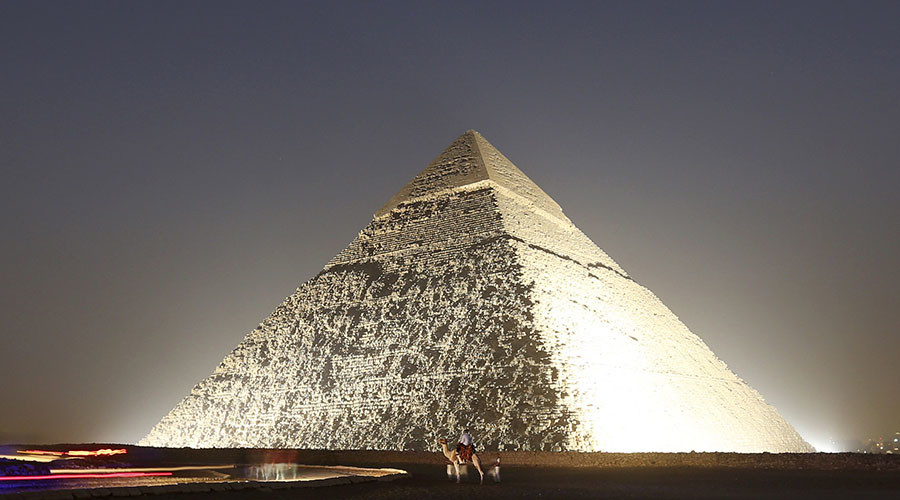
Day after day, the importance of confronting climate change issues is increasing as apparent damage can affect everything.
This doesn’t only apply to the rising or falling weather temperatures or sea levels but there is also constant threat of the disappearance of entire landmarks and cities: including the pyramids and Sphinx.
Recently, global warming has caused alarm around the impact of climate change on Egyptian antiquities.
These statements were made according to ARTnews.
The website stated that temperatures in Egypt are rising at a quick rate and most experts expect an average temperature increase of more than 3F with each successive decade.
Temperatures exceeding 37.8C in Aswan warn of damage to ancient granite monuments, while radical shifts between Aswan’s hot days and cold nights are. Causing cracks in the granite.
This leads to the destruction of inscriptions on antiquities.
The agricultural irrigation of the villages near the pyramids also lead to a rise in the level of groundwater and the inability of the soft soil to absorb it, so surface runoff gathered around the feet of the Sphinx.
Sea level rise caused by climate change threatens to flood archaeological sites in Egypt.
These include the ancient temples in Luxor, and most of the city of Alexandria, built by Alexander the Great in 331 BC.
There is also recent warnings that the Citadel of Qaitbay may disappear due to climate change.
The problem of global warming and climate change threaten to melt ice and increase sea levels, which may cause some regions of the world to drown, Hussein Abdel-Basir, Director of the Antiquities Museum at the Bibliotheca Alexandrina, said.
He added, in his interview with Al-Masry Al-Youm, that climate changes threaten the Alexandria and Delta region, so the Egyptian government is implementing a comprehensive plan.
This will be supervised by the Ministry of Environment, to create huge concrete blocks in front of many areas in Alexandria.
Other areas of concern that might be affected are places on the coast of the Mediterranean Sea.
“The danger is inevitably coming.. Therefore, we call for a faster pace of work”.
Abdel Basir also pointed a comparison with other drowning cities globally, including Miami in the US and Shanghai in China.
The Ministry of Environment warned that the Delta and Alexandria are among the most threatened areas with drowning, he added.
Abdel Basir explained that the pyramids are affected by air pollution and high carbon emissions, adding that the pyramids are built of limestone, so the more pollution existed, the more its features were eroded, which was evident in the Cleopatra Obelisk in Alexandria, from which the hieroglyphic writing disappeared.
He pointed out that the temples in Luxor and Upper Egypt in general are affected by the increase in the percentage of pollution, exhaust and groundwater, adding that there are projects implemented to save the ruins of Kom al-Shuqafa area from groundwater, as well as the Sphinx to reduce the percentage of water below it to six meters, so that the body of the statue is not affected, as well as the Habu temple in Luxor.
In November, The New York Times reported that the tombs in Luxor’s Valley of the Kings would “completely disappear” within a century unless urgent action was taken, especially since some temple stones already show erosion from moisture.
Abdel Basir excluded thoughts that this will happen in 100 years, adding that the matter may not be due to climate changes, but also because of the human impact, which requires reducing human contact with antiquities.
Abdel Basir called for measures to be taken to protect the Valley of the Kings in the event of heavy rains in Upper Egypt, and to launch a campaign similar to the campaign that saved the monuments of Nubia from drowning during the construction of the High Dam.
In turn, Magdy Allam, an environmental expert, said that climate change threatens the antiquities of the world, not only Egypt, as there are six elements that lead to greenhouse gases and leave dangerous effects on buildings and monuments.
He explained that the mixing of these gases with moisture leads to burning acids similar to “fire water” that erode parts of the antiquities, and this is one of the reasons for the continued restoration of antiquities around the world.
Allam added that the increase in heat harms the antiquities, especially the limestone stones, in addition to the wrong use that may lead to damage to the antiquities. The entry of a large number of people inside the ancient tombs or temples leads to an increase in the production of carbon dioxide, which threatens the the antiquity, as well as the presence of parking lots and and vehicles near the monument.
Allam explained that the damage that the monuments may suffer is due to several factors, including pollution resulting from transport, whether cars or planes, and climatic effects such as: extreme heat or extreme drought or humidity and torrential rains, and the proximity of the monuments to civilian areas.
Allam pointed out that the ancient Egyptians were people of extraordinary genius in engineering sciences, astronomy, and the environment. Therefore, they built the pyramids at a height in a way that made them protected and steadfast throughout the ages, stressing the importance of a distance of not less than 100 meters between the antiquities and the areas adjacent to it.
Allam concluded saying that as long as there are human activities close to the antiquity, it will erode faster, especially since the Egyptian antiquities from Aswan to Giza are close to the Nile and human life along Nile.
The Egyptian government has taken steps to mitigate climate change, and this year launched the National Climate Change Strategy, which funds sustainable projects. US$13 million has been allocated to preserve Qaitbay Citadel from rising sea levels.




